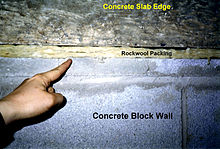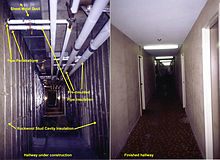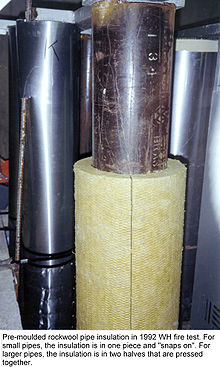- Mineral wool
-
 Building joint with incomplete firestop made of mineral wool packing that still requires topcaulking.
Building joint with incomplete firestop made of mineral wool packing that still requires topcaulking.
 Common insulation applications in an apartment building.
Common insulation applications in an apartment building.
 Mineral wool pipe covering applied to a steel pipe for a fire test.
Mineral wool pipe covering applied to a steel pipe for a fire test.
Mineral wool, mineral fibers or man-made mineral fibers are fibers made from natural or synthetic minerals or metal oxides. The latter term is generally used to refer solely to synthetic materials including fiberglass, ceramic fibers and stone wool. Industrial applications of mineral wool include thermal insulation (as both structural insulation and pipe insulation), filtration, soundproofing, and germination of seedlings.
Contents
History
Slag wool was first made in 1840 in Wales by Edward Parry but the harmful effects on the workers caused production to be abandoned.[1] It was first produced commercially in 1871 at the Georgsmarienhütte in Osnabrück Germany.
Manufacture
Stone wool is a furnace product of molten rock at a temperature of about 1600 °C, through which a stream of air or steam is blown. More advanced production techniques are based on spinning molten rock on high speed spinning wheels somewhat like the process used to prepare cotton candy. The final product is a mass of fine, intertwined fibres with a typical diameter of 6 to 10 micrometers. Mineral wool may contain a binder, often food grade starch, and an oil to reduce dusting.
Usage
Though the individual fibres conduct heat very well, when pressed into rolls and sheets their ability to partition air makes them excellent heat insulators and sound absorbers. Though not immune to the effects of a sufficiently hot fire, the fire resistance of fibreglass, stone wool and ceramic fibres makes them common building materials when passive fire protection is required, being used as spray fireproofing, in stud cavities in drywall assemblies and as packing materials in firestops.
Mineral wools are unattractive to rodents but will provide a structure for bacterial growth if allowed to become wet.
Other uses are in resin bonded panels, growth medium in hydroponics, filler in compounds for gaskets, brake pads, in plastics in the automotive industry and as a filtering medium.
Mineral fibres are produced in the same way, without binder. The fibre as such is used as a raw material for its reinforcing purposes in various applications, such as friction materials, gaskets, plastics and coatings.
The heat that the material can withstand is:
Material Temperature Glass wool 230 - 250 °C Stone wool 700 - 850 °C Ceramic fibre wool 1200 °C In hydroponics
Mineral wool products can hold large quantities of water and air that aids root growth and nutrient uptake in hydroponics; their fibrous nature also provides a good mechanical structure to hold the plant stable. The high natural pH of mineral wool makes them initially unsuitable to plant growth and requires "conditioning" to produce a wool with an appropriate, stable pH.
Safety of material
Precautions need to be taken when handling a fibre product as it can irritate the eyes, skin and respiratory tract. Prolonged exposure could lead to long term effects and some types of mineral wool are considered a possible carcinogen to humans, similar to asbestos[citation needed]. This effect may depend upon the fibre diameter and length, chemical composition and persistence within the body.
IARC (the International Agency for Research on Cancer) has reviewed the carcinogenicity of man made mineral fibres in October 2002.[3] The IARC Monograph's working group concluded that only the more biopersistent materials remain classified by IARC as "possibly carcinogenic to humans" (Group 2B). These include refractory ceramic fibres, which are used industrially as insulation in high-temperature environments such as blast furnaces, and certain special-purpose glass wools not used as insulating materials. In contrast, the more commonly used vitreous fibre wools including insulation glass wool, stone wool and slag wool are considered "not classifiable as to carcinogenicity in humans" (Group 3).
High bio soluble fibres (HT-fibres) are produced that do not cause damage to the human cell. These newer biosoluble materials have been tested for carcinogenicity and most are found to be non-carcinogenic, or to cause tumours in experimental animals only under very restricted conditions of exposure. The IARC Monograph's working group "elected not to make an overall evaluation of the newly developed fibres designed to be less biopersistent such as the alkaline earth silicate or highalumina, low-silica wools. This decision was made in part because no human data were available, although such fibres that have been tested appear to have low carcinogenic potential in experimental animals, and because the Working Group had difficulty in categorizing these fibres into meaningful groups based on chemical composition."[4]
This irritation to the skin is not a chemical irritation but only a temporary mechanical irritation, comparable with exposure of the skin to bio soluble materials such as straw, grass, or hay.
See also
References
- ^ Workshop Receipts, By Ernest Spon, Robert Haldane, Charles George Warnford Lock, Published by E. & F. N. Spon, 1889, Item notes: v.3
- ^ "Competition Commission Alternatives to Glass Mineral Wool". http://www.competition-commission.org.uk/inquiries/completed/2004/superglass/glass_wool_report.pdf. 090820 competition-commission.org.uk, 2.2 Mineral Wools
- ^ IARC Monographs on the Evaluation of Carcinogenic Risks to Humans, Volume 81 (2002), Man-made Vitreous Fibres (PLEASE NOTE: Some manufacturers of insulation products have cited this volume while making erroneous claims that "IARC scientists confirm safety of mineral wool insulation". These claims are false. The findings in this volume are not a determination of non-carcinogenicity or overall safety.)
- ^ IARC Monographs on the Evaluation of Carcinogenic Risks to Humans, Volume 81 (2002), Man-made Vitreous Fibres, Overall evaluation, p. 339
External links
- "Mineral Wool 1200 MSDS". icainsulation.com. http://www.icainsulation.com/msdsmw1200.html. Retrieved May 20, 2010.
- Thermal Insulation Association of Canada
- Master Insulators Association of Ontario
- Engineeringtoolbox.com treatise on mineral wool
- Canadianhomeworkshop.com Article: Know your insulation
- Statistics Canada documents on shipments of mineral wool in Canada
- Review of published data on exposure to mineral wool during installation work by A Jones and A Sanchez Jimenez, Institute of Occupational Medicine Research Report TM/11/01
Categories:- Materials
- Building insulation materials
Wikimedia Foundation. 2010.


